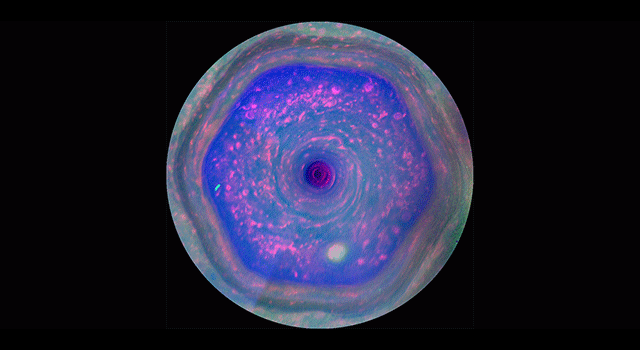Since the Voyager mission in 1981-82, and after with the Cassini mission (since 2006), around the north pole of Saturn has been observed a persisting hexagonal could pattern.

The cloud is located about 78 degrees North, and it’s sides are about 14 km long (even longer than the Earth’s diameter. The hexagonal shape rotates with a period of 10 hours, 39 minutes and 24 seconds (same as the period of Saturn’s radio emissions from it’s interior). Anyway the hexagon observed around Saturn’s north pole does not shift in longitude (like it happens with other clouds in the visible atmosphere).
It seems that Saturn South Pole does not have a hexagonal shape, altough it has a vortex (as also a vortex has been found inside the North Pole hexagon).
(from NASA) “They saw the storm around the pole, as well as small vortices rotating in the opposite direction of the hexagon. Some of the vortices are swept along with the jet stream as if on a racetrack. The largest of these vortices spans about 2,200 miles (3,500 kilometers), or about twice the size of the largest hurricane recorded on Earth.”
Within the Cassini mission, a video has been recorded, and can be seen below.
For further information about “The Hexagon”, as well as some 3D images of it, you can visit the NASA Page.
Some scientists tried to theorize an explanation, saying that the hexagon forms are a latitudinal gradient in the speed of the atmospheric winds in Saturn’s atmosphere.
They recreated similar regural shapes in the labs, when rotating a circular tank of liquid at different speeds at its center and periphery. They saw most commonly six sided shapes, as well as other kind of shapes (from 2 to 8 sides). Shapes took form in an area of turbulent flow between two bodies. stable vortices of similar size formed on the slower side (south side) of the fluid boundary.

“Polygons do not form at wind boundaries unless the speed differential are within certain margins and so are not present at other likely place such as Saturn’s South pole and the poles of Jupiter.”
Could wind form this polygonal shapes just at certain frequencies? Time to investigate some more.
